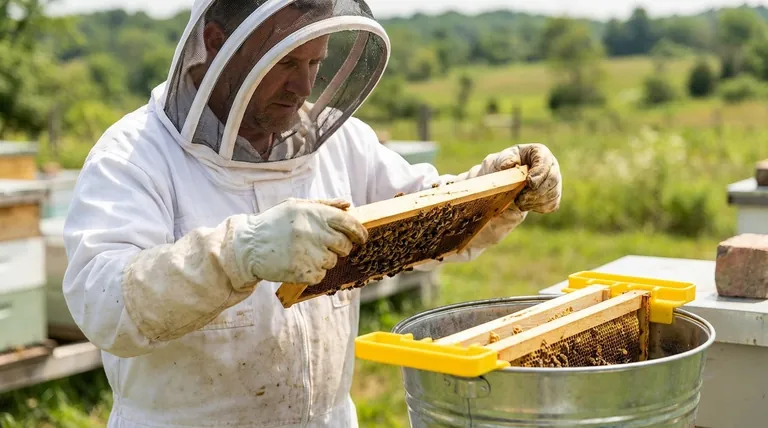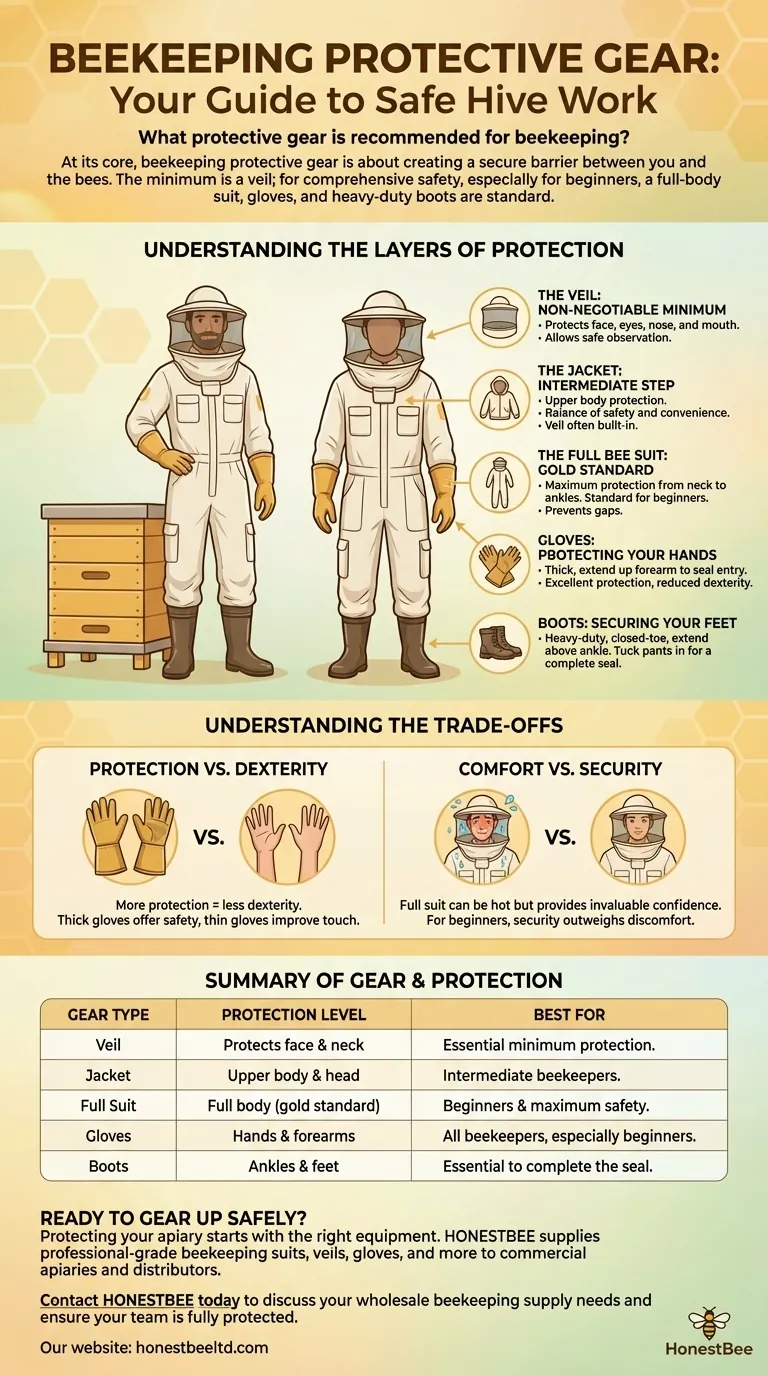At its core, beekeeping protective gear is about creating a secure barrier between you and the bees. The minimum recommended gear is a veil to protect your face and eyes. However, for comprehensive safety, especially for beginners, a full-body beekeeping suit, gloves, and heavy-duty boots are the standard.
The goal of protective gear is not just to prevent stings, but to give you the confidence to work calmly and effectively with your hives. While options range from a simple veil to a full suit, the wisest approach is to start with more protection than you think you need.

Understanding the Layers of Protection
Your choice of gear depends on your comfort level, the temperament of your bees, and the task at hand. The equipment is designed to protect vulnerable areas in layers.
The Non-Negotiable Minimum: The Veil
The single most important piece of protective equipment is a beekeeping veil. Stings to the face, particularly around the eyes, nose, and mouth, are dangerous and extremely painful.
A veil ensures your head and face are shielded, allowing you to observe the hive without the risk of a defensive bee flying into a sensitive area.
The Intermediate Step: The Beekeeping Jacket
For beekeepers who want more than a veil but less than a full suit, a beekeeping jacket is an excellent compromise. These jackets typically have a veil built into the hood.
They provide solid protection for your entire upper body and are easier to put on and take off than a full suit, offering a good balance of safety and convenience.
The Gold Standard: The Full Bee Suit
A full-body bee suit, or coveralls, offers the highest level of protection. It covers you from your neck to your ankles, leaving no gaps for bees to enter.
This is the standard recommendation for all new beekeepers. It allows you to learn how to handle bees without the fear and distraction of stings, fostering a calmer and more productive experience.
Protecting Your Hands: Gloves
Beekeeping gloves are thick, typically made of leather or durable synthetics, and extend up the forearm to seal a common entry point.
While they provide excellent protection, they reduce dexterity. Some experienced beekeepers opt for thinner nitrile gloves or work barehanded, but this increases sting risk and is not advised for beginners.
Securing Your Feet: Boots
Bees can and will crawl, often seeking to sting ankles. Heavy-duty, closed-toe boots that extend above the ankle are essential. You should tuck your suit's pant legs into your boots to create a complete seal.
Understanding the Trade-offs
Choosing your gear involves balancing competing priorities. There is no single "perfect" setup, only the right setup for your specific situation.
Protection vs. Dexterity
There is a direct trade-off between how protected you are and how easily you can manipulate frames and tools.
Thick gloves and full suits offer maximum protection but can feel clumsy. Working with less gear improves your sense of touch but leaves you vulnerable, which can be a problem if a hive becomes unexpectedly defensive.
Comfort vs. Security
A full bee suit can be hot and cumbersome, especially in warm climates. However, the feeling of security it provides is invaluable.
For beginners, the mental comfort of being fully protected far outweighs the physical discomfort. This confidence allows you to move slowly and deliberately, which in turn leads to calmer bees.
The Risk of Complacency
As beekeepers gain experience, it's common to shed layers of gear. This is a personal decision based on sting tolerance and knowledge of a specific colony's temperament.
However, any hive can have a "bad day." It is always advisable to have your full set of protective gear on hand, even if you don't plan to use it for a quick inspection.
Making the Right Choice for Your Gear
Your approach to protective gear should align directly with your experience level and a realistic assessment of risk.
- If you are a new beekeeper: Your only choice should be a full suit, veil, gloves, and boots. This maximizes safety and allows you to build confidence.
- If you are an experienced hobbyist with calm hives: A jacket and veil combination may offer a sufficient balance of protection and comfort for routine inspections.
- If your priority is maximum safety, regardless of experience: Always use a full, properly sealed bee suit, gloves, and closed-toe boots for any hive work.
Equipping yourself correctly is the first step toward a safe and rewarding beekeeping journey.
Summary Table:
| Gear Type | Protection Level | Best For |
|---|---|---|
| Veil | Protects face & neck | Essential minimum protection |
| Jacket | Upper body & head | Intermediate beekeepers |
| Full Suit | Full body (gold standard) | Beginners & maximum safety |
| Gloves | Hands & forearms | All beekeepers, especially beginners |
| Boots | Ankles & feet | Essential to complete the seal |
Ready to gear up safely?
Protecting your apiary starts with the right equipment. HONESTBEE supplies professional-grade beekeeping suits, veils, gloves, and more to commercial apiaries and distributors through our wholesale operations.
We understand that your safety and efficiency are paramount. Our gear is designed for durability and maximum protection, giving you the confidence to work with your hives effectively.
Contact HONESTBEE today to discuss your wholesale beekeeping supply needs and ensure your team is fully protected.
Visual Guide

Related Products
- Yellow Plastic Bucket Pail Perch for Beekeeping
- Professional 3-Bar Frame Grip with Integrated Hive Tool
- Professional Dual-End Stainless Steel Hive Tool for Beekeeping
- Wooden Bee Brush with Triple Row Artificial Fiber for Beekeeping
- Plastic Bee Hive Stand for Beekeeping
People Also Ask
- Why is proper beekeeping equipment important? Essential for Safety and Hive Health
- What equipment do you need to make honey? A Complete Guide to Starting Your Apiary
- What should beginners consider when purchasing beekeeping equipment? A Guide to Essential Starter Gear
- What is the best place to keep bees? Find the Perfect Apiary Site for Your Hives
- What does every bee keeper need? Your Essential Guide to Starting Strong



















